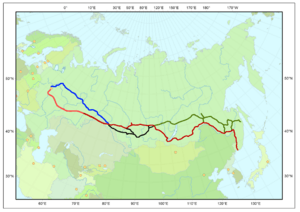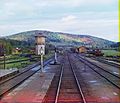Trans-Siberian railway facts for kids
The Trans-Siberian Railway is a famous network of train lines in Russia. It connects Moscow in European Russia to the Russian Far East. Some lines also go to Mongolia, China, and the Sea of Japan. It is one of the longest railways in the world.
Russia is a huge country, so traveling from one side to the other was a big challenge. In the 1890s, Russia started building this railway. It was meant to link Moscow with the Pacific Ocean. Before the railway, a trip across Russia could take about a year on rough roads.
One main reason for building the "Trans-Sib" was for the military. It helped move soldiers to the East. This was to protect the country, especially from countries like Japan and China. Another reason was to move food. Food from farms in southwestern Siberia could reach people in European Russia. Many cities and businesses grew along the railway's path.
Contents
Why Was the Railway Built?
The Trans-Siberian Railway was built for several important reasons. Russia needed a faster way to connect its vast lands.
Connecting East and West
Russia stretches across two continents: Europe and Asia. Before the railway, moving people and goods across this huge distance was very slow. The railway made travel much quicker and easier. It helped unite the country.
Helping the Military
The railway was very important for defense. It allowed Russia to quickly move soldiers and supplies. This was especially useful for protecting its eastern borders. It helped Russia respond faster to any threats.
Moving Food and Goods
Farmers in Siberia grew a lot of food. The railway helped transport this food to cities in European Russia. It also moved raw materials and finished products. This helped industries grow all along the route. Many new towns and factories appeared because of the railway.
Journey Along the Trans-Siberian Railway
Traveling on the Trans-Siberian Railway is an amazing adventure. It crosses many different landscapes and time zones.
Starting in Moscow
The journey usually begins at Yaroslavsky Station in Moscow. From there, trains head east. They pass through many historic Russian cities. The trip takes about seven days to reach the Pacific Ocean.
Crossing Siberia
The railway goes through the vast forests of Siberia. Travelers see endless taiga, which are huge pine forests. They also pass by large rivers like the Volga and Ob. The scenery changes a lot during the long journey.
Lake Baikal
One of the most beautiful parts of the trip is near Lake Baikal. This is the deepest lake in the world. The railway runs right along its shore. It offers stunning views of the lake and mountains.
Reaching the Pacific Ocean
The main line ends in Vladivostok. This city is a major port on the Pacific Ocean. There is a special marker there. It shows the end of the 9,288-kilometer (5,771-mile) journey.
Impact of the Railway
The Trans-Siberian Railway changed Russia in many ways. It had a big impact on trade, travel, and how people lived.
Economic Growth
The railway helped Russia's economy grow. It made it easier to transport goods. This led to new industries and jobs. Cities along the route became important centers for trade and business.
Population Movement
Many people moved to Siberia because of the railway. They settled in new towns and farmed the land. This helped develop the less populated eastern parts of Russia.
Cultural Connections
The railway also helped connect different cultures. It brought people from various regions closer together. It made travel and communication easier across the vast country.
Images for kids
-
The Trans-Siberian is a vital link to the Russian Far East.
-
A Bashkir switchman near Ust-Katav in the Ural Mountains, around 1910
-
Food sellers at a Trans-Siberian Railway station, offering local foods like fish and pirozhki.
-
The Vladivostok station, end of the Trans-Siberian Railway
-
Bridge over the Kama River near Perm, built in 1912
See also
 In Spanish: Transiberiano para niños
In Spanish: Transiberiano para niños

















